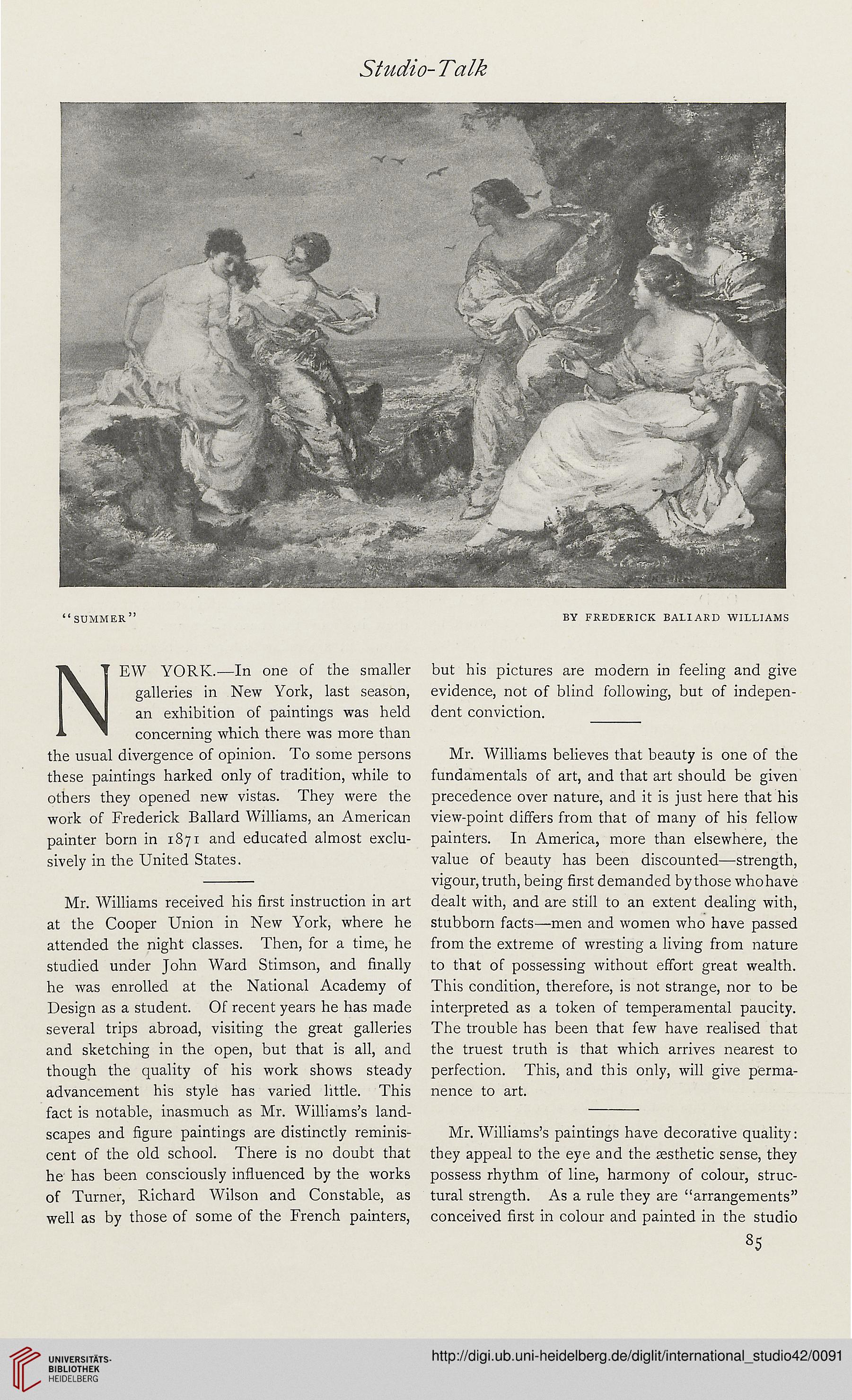Studio- Talk
NEW YORK.—In one of the smaller
galleries in New York, last season,
an exhibition of paintings was held
concerning which there was more than
the usual divergence of opinion. To some persons
these paintings harked only of tradition, while to
others they opened new vistas. They were the
work of Frederick Ballard Williams, an American
painter bom in 1871 and educated almost exclu-
sively in the United States.
Mr. Williams received his first instruction in art
at the Cooper Union in New York, where he
attended the night classes. Then, for a time, he
studied under John Ward Stimson, and finally
he was enrolled at the National Academy of
Design as a student. Of recent years he has made
several trips abroad, visiting the great galleries
and sketching in the open, but that is all, and
though the quality of his work shows steady
advancement his style has varied little. This
fact is notable, inasmuch as Mr. Williams's land-
scapes and figure paintings are distinctly reminis-
cent of the old school. There is no doubt that
he has been consciously influenced by the works
of Turner, Richard Wilson and Constable, as
well as by those of some of the French painters,
but his pictures are modern in feeling and give
evidence, not of blind following, but of indepen-
dent conviction.
Mr. Williams believes that beauty is one of the
fundamentals of art, and that art should be given
precedence over nature, and it is just here that his
view-point differs from that of many of his fellow
painters. In America, more than elsewhere, the
value of beauty has been discounted—strength,
vigour, truth, being first demanded by those who have
dealt with, and are still to an extent dealing with,
stubborn facts—men and women who have passed
from the extreme of wresting a living from nature
to that of possessing without effort great wealth.
This condition, therefore, is not strange, nor to be
interpreted as a token of temperamental paucity.
The trouble has been that few have realised that
the truest truth is that which arrives nearest to
perfection. This, and this only, will give perma-
nence to art.
Mr. Williams's paintings have decorative quality:
they appeal to the eye and the esthetic sense, they
possess rhythm of line, harmony of colour, struc-
tural strength. As a rule they are "arrangements"
conceived first in colour and painted in the studio
85
NEW YORK.—In one of the smaller
galleries in New York, last season,
an exhibition of paintings was held
concerning which there was more than
the usual divergence of opinion. To some persons
these paintings harked only of tradition, while to
others they opened new vistas. They were the
work of Frederick Ballard Williams, an American
painter bom in 1871 and educated almost exclu-
sively in the United States.
Mr. Williams received his first instruction in art
at the Cooper Union in New York, where he
attended the night classes. Then, for a time, he
studied under John Ward Stimson, and finally
he was enrolled at the National Academy of
Design as a student. Of recent years he has made
several trips abroad, visiting the great galleries
and sketching in the open, but that is all, and
though the quality of his work shows steady
advancement his style has varied little. This
fact is notable, inasmuch as Mr. Williams's land-
scapes and figure paintings are distinctly reminis-
cent of the old school. There is no doubt that
he has been consciously influenced by the works
of Turner, Richard Wilson and Constable, as
well as by those of some of the French painters,
but his pictures are modern in feeling and give
evidence, not of blind following, but of indepen-
dent conviction.
Mr. Williams believes that beauty is one of the
fundamentals of art, and that art should be given
precedence over nature, and it is just here that his
view-point differs from that of many of his fellow
painters. In America, more than elsewhere, the
value of beauty has been discounted—strength,
vigour, truth, being first demanded by those who have
dealt with, and are still to an extent dealing with,
stubborn facts—men and women who have passed
from the extreme of wresting a living from nature
to that of possessing without effort great wealth.
This condition, therefore, is not strange, nor to be
interpreted as a token of temperamental paucity.
The trouble has been that few have realised that
the truest truth is that which arrives nearest to
perfection. This, and this only, will give perma-
nence to art.
Mr. Williams's paintings have decorative quality:
they appeal to the eye and the esthetic sense, they
possess rhythm of line, harmony of colour, struc-
tural strength. As a rule they are "arrangements"
conceived first in colour and painted in the studio
85




